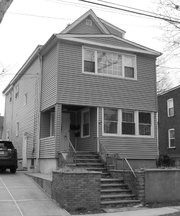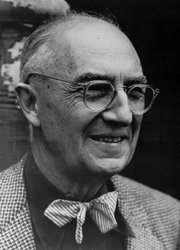
|
Thaddeus Marshall, the owner of the
most famous red wheelbarrow in literary history.
|
For decades, much has depended on his red wheelbarrow, streaked with rain, next to some white chickens, even if no one has known — or perhaps even wondered — exactly who he was.
But now, the owner of the humble garden tool that inspired William Carlos Williams’s classic poem “The Red Wheelbarrow” will finally get his due.
On July 18, in a moment of belated poetic justice, a stone will be laid on the otherwise unmarked grave of Thaddeus Marshall, an African American street vendor from Rutherford, N.J., noting his unsung contribution to American literature.
“When we read this poem in an anthology, we tend not to think of the chickens as real chickens, but as platonic chickens, some ideal thing,” William Logan, the scholar who recently discovered Mr. Marshall’s identity, said in an interview.
The discovery doesn’t change the meaning, he said, but “knowing there was a man with a particular wheelbarrow and some chickens does help us understand the world the poem was embedded in.”
Williams’s 16word poem, first published in 1923, was hailed as a manifesto of plainspoken American modernism. Williams himself declared it “quite perfect.” A staple of classrooms and anthologies, it has inspired endless debates about its deeper meaning — how much of what, exactly, depends on the red wheelbarrow? — not to mention provided the name of an Englishlanguage bookstore in Paris, a craft beer from Maine and an episode of “Homeland.”
But Mr. Logan, a professor at the University of Florida who has contributed to The New York Times Book Review, may have taken the poem’s fullest measure yet. His roughly 10,000word essay on the poem, published in the most recent issue of the literary journal Parnassus and titled simply “The Red Wheelbarrow,” considers the poem from seemingly every conceivable angle.
There are discussions of Williams’s aesthetic influences and composition habits. (Williams, a medical doctor by profession, sometimes wrote poems on prescription forms.) Mr. Logan also considers the history of hyphenation in the word “rainwater,” previous literary references to painted wheelbarrows, New Jersey ordinances concerning handcarts, and early20thcentury poultry trends.
“Who knew there was a fad for white chickens?” he said.
His most notable detective work, however, concerns Mr. Marshall, about whom Williams offered some clues but never fully identified.
In a note quoted in a 1933 anthology, Williams said he had seen the wheelbarrow “outside the window of an old negro’s house on a backstreet” in Rutherford, where Williams also lived and regularly paid house calls to patients in the African American neighborhood.
 |
Marshall's former home
in Rutherford, N.J.
|
“The sight impressed me somehow as about the most important, the most integral that it had ever been my pleasure to gaze upon,” he said.
In an essay in Holiday magazine in 1954, Williams (who died in 1963) gave the man’s last name as Marshall, noting that he had once made a living fishing for porgies off Gloucester, Mass.“I liked that man, and his son Milton almost as much,” he wrote. “I suppose my affection for the old man somehow
got into the writing.” Mr. Logan looked in the 1920 census and found only one possible candidate: Thaddeus Marshall, a 69 year old widower who lived with a son named Milton at 11 Elm Street, about nine blocks from Williams’s house.
With the help of Rod Leith, the borough historian of Rutherford, Mr. Logan tracked down a detailed 1917 fire insurance map of the neighborhood that showed a large chicken coop at the rear of the property. While Mr. Marshall’s house still stands, the coop is long gone. As for the
wheelbarrow, Mr. Logan found no concrete trace of it, though not for lack of trying.
He discovered that Rutherford, unlike other cities in New Jersey, did not require that carts used for commercial purposes be registered. Besides, by the time Williams saw the wheelbarrow, both it and Mr. Marshall may have been retired.
The 1910 census listed Mr. Marshall’s occupation as “street huckster,” or vendor, but by 1920, no profession was listed. Mr. Logan cautions against finding definitive meanings in the poem’s “Rorschach blot,” but he speculates that for Williams, “the barrow might have stood for a way of life recently vanished.”

|
The poet and doctor
William Carlos Williams, who wrote
“The Red Wheelbarrow.” |
Mr. Logan also thinks he sees Mr. Marshall, sans wheelbarrow, in Williams’s poem “St. Francis Einstein of the Daffodils,” which refers to
the bare chickenyard
of the old negro
with white hair who hides
poisoned fishheads
here and there.
Meanwhile, Mr. Leith, the Rutherford historian, has tracked him a bit farther in the real world. He located a greatgranddaughter, Teresa Marshall Hale, of Roselle, N.J., who grew up in the house on Elm Street and recalled family stories about her greatgrandfather selling eggs and vegetables.
Growing up in Rutherford, she had learned about Williams (who was the doctor at her father’s birth and also signed her grandmother’s death certificate) in school, but was unfamiliar with the poem.
“I’m in awe,” Ms. Hale, 69, a compliance officer for the New Jersey Turnpike Authority, said of the connection. “To think that the real person who inspired it was my greatgrandfather, and that I lived in the same house he lived in, and looked out the same windows at the same yard, is overwhelming.”
Ms. Hale will deliver a brief eulogy on July 18, when the marker will be put on Mr. Marshall’s grave at East Ridgelawn Cemetery in Clifton, N.J., where he was buried in 1930 without a headstone. Mr. Leith raised nearly $1,000 for the marker, with donations from Ms. Hale and Daphne Williams Fox, a granddaughter of the poet, who lives in Rutherford, among others. A red and white wreath, signifying the red wheelbarrow and white chickens, will be laid beside it.
Mr. Leith said the marker was a tangible link between Williams and the AfricanAmerican fellow citizens he frequently treated but rarely wrote about
explicitly.
“Williams is celebrated as by far the most important person to come out of Rutherford,” he said. “But this part of the history has been lost.”